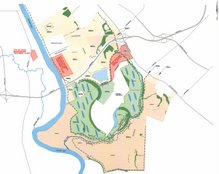We know that wetlands are cheaper, mean lower sewer rates, do the treatment job better, provide park settings for people and natural habitat for animals, and provide research opportunities for research universities. Is it possible they reduce greenhouse gasses too?
Columbia has committed to Cool Cities, a Sierra Club program to address global warming on a city-by-city basis. Step 1 of Cool Cities “sets the goal of reducing citywide global warming carbon dioxide (CO2) pollution to 7 percent below 1990 levels by 2012.” Mayor Coble is now driving a Prius, a hybrid vehicle that uses 25% of the gasoline of an SUV or 50% of the gasoline of a normal small car.
These wetlands will be a bigger help (and, if you count the fact that they save money, they will cost less too). Studies have shown that constructed treatment wetlands, when properly designed and operated, are most effective in causing a net reduction in CO2.
We all learned in grade school that plants take up CO2. What we (or at least I) didn’t learn is that using electricity means releasing a lot of carbon dioxide into the atmosphere. Power plants around here, except nuclear and hydro, burn things to make electricity. And that burning releases CO2 into the atmosphere. Thus even electric cars, to the extent they plug in to the grid, cause CO2 releases. Right now, based on third party calculations and the assumption that Columbia Metro pays $0.05 per kilowatt hour for electricity, the sewer plant on the Congaree presently uses electricity enough to release 55 tons of CO2 per day into the atmosphere. That’s the equivalent of having more than 2,500 SUVs in the Columbia fleet. And there is probably little that can be done about that.
What can be affected is the amount of CO2 that will be released when tertiary treatment is required and installed. PG&E estimates that adding conventional tertiary treatment will cause a 40-50% rise in electricity usage at a sewer plant. Treatment wetlands, on the other hand, can use very little electricity. For example, the total annual budget for Orlando Wetlands, including the staff of five, is less than 30% of the current Columbia Metro electric bill. In fact, if you use the calculators provided by the EPA and a little math you see the difference in CO2 emissions between the proposed treatment wetlands and the conventional treatment is equal to about 22 tons of CO2 per day, or 1,000 SUVs.
Sunday, February 18, 2007
Subscribe to:
Post Comments (Atom)

No comments:
Post a Comment